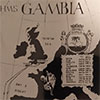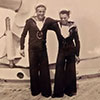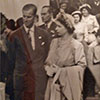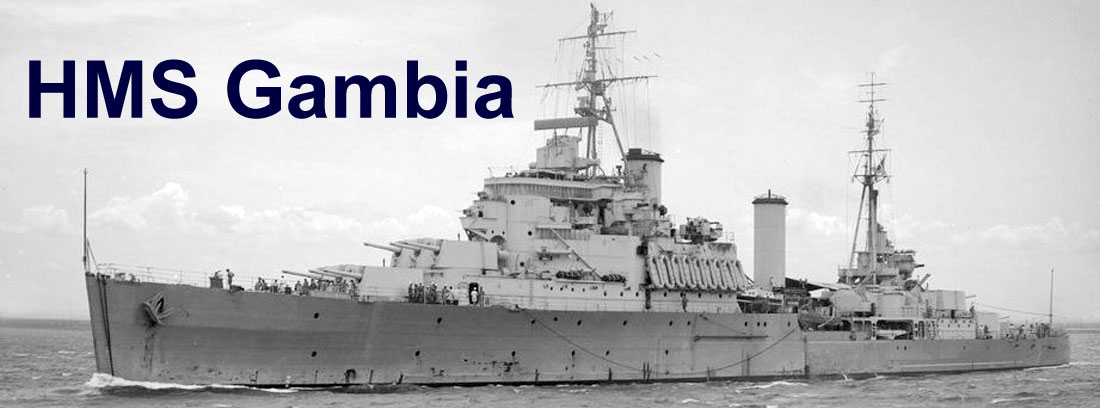
Frank Graham Headon
I am very grateful to Michael Headon, the son of Frank Graham Headon who served on HMS Gambia from March 12, 1953 to June 20, 1954. Michael first contacted me in January 2021 asking if I knew anything about his father's service. I didn't but Michael very kindly sent the information that makes up this page.
Frank was born on August 2, 1935 and shortly after his farming parents moved to Stone Moor (now called Pelham), near Chawleigh, in Devon. In 1943, the family moved again to Rocombe, in South Devon and again in 1946 to Dunston. Frank left school and joined the Royal Navy on October 3, 1950.
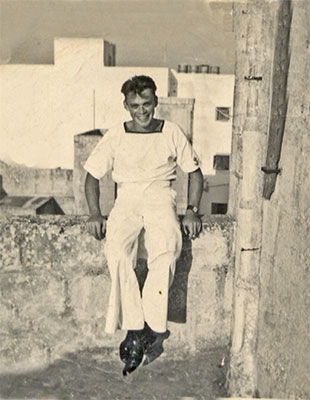
Frank did his initial training at HMS St. Vincent, the Gosport shore establishment from October 3, 1950 to 19th October 19, 1951. He wrote of this time:
4.30 on a pleasant Sunday afternoon, 3rd October 1950! Over time I may have forgotten many dates, but this was certainly not going to be one of them. First meal in His Majesty’s Royal Navy. There it was in all its glory waiting for us, a large white dinner plate, one thick slice of bread cut mechanically from an old type sandwich loaf topped with a small cube of rock-hard margarine. Alongside the plate was a large white china mug, half full of lukewarm tea. Nothing homely or inviting about this place.
We were going to spend four weeks in this area being kitted up, fitted out and indoctrinated into the Navy. I do not remember being told, but found out a lot later, that during those first four weeks we could have walked out, I don’t think anyone did. We were probably too scared to go against the flow.
We were taught how to march, salute, and sew, yes sew. When we had received all our kit, we were instructed how to mark it, in the main we had to sew our names in chain stitch with red Sylko. Our new wardrobe was also stamped in black ink, with our names. The letters were about half an inch tall. We were given a certain amount of time over the four weeks to finish the job. This was fine for someone called John Dee, ‘J. Dee’, but there were a range of names, the worst I think was ‘Michael William Albert Higginbottom’ or something similar, ‘M.W.A. Higginbottom’. He had a few late nights.
Also, we had to be taught to fold and iron every piece in a certain way. Believe it or not there was a very good reason for this, whenever you moved ship your belongings had to be packed into your kitbag, again in a very special manner so that when you next came to use it, all the creases would be in the right place.
Kit lockers had to be set out in exactly the same manner, bedding had to be folded and laid out in the regulation style. Only ‘Perfect’ was acceptable.
There were rules for everything, break them at your peril. The dormitories were like a shrine, always everything in its place.
Golden Rules :-
1. Thou shall not wear your boots in the dormitory
2. Thou shall not wear your hat in the dormitory
3. Thou shall not smoke in the dormitoryOne morning it was getting time for parade, blast! I had forgotten something. A quick check, no one in sight, I tiptoed into and across the dorm, fag in mouth, hat on and worst of all my boots still on my feet. I reached my bed, took whatever I had forgotten, just about to retreat, when ‘Boom’, the silence was shattered. ’WHAT THE HELL ARE YOU DOING IN HERE?’, report to the office after parade! I crept away worried to death about what was going to happen to me. Perhaps I’ll be flogged. The parade took about thirty to forty-five minutes and we were then dismissed prior to going onto some other activity. Go to the office? I never did, and no one everquestioned me about it again.
As this proved to be the case on other occasions, we were now just a number, not a face to be recognised, not a person, just a tiny cog in a huge wheel. For these first four weeks we were put through the grinder.
HMS Widemouth Bay. Rosyth. October 20, 1951 to January 18, 1952
My first real ship, based at Rosyth in Scotland, if you are prone to sea sickness the waters around the north of Scotland are not a place you would want to be. I was a little luckier than most. Rough seas were okay but it was the slow rise and fall of the ship, together with copious supplies of diesel fumes that would occasionally force me to eject my supper into the North Sea. It must have been sometime in January 1952, we were duty frigate when the call came in that a trawler was in trouble somewhere in the bleak, cold, rough and gale torn expanse of water east of the Scottish shore line. I cannot remember seeing a trawler, some other ship must have arrived, and given aid before we could make it. In conditions like these everything not bolted down had to be tied down. Meal times were interesting.
HMS Drake, Royal Navy Barracks, Devonport. (Now known as Her Majesty’s Naval Base). January 19 to February 21, 1952
HMS Chivalrous, 1st Destroyer Squadron. Mediterranean Fleet. Selema Creek, Malta. February 22, 1952 to February 11, 1953
HMS Gambia, Colony class Cruiser. Cruiser Squadron. Mediterranean Fleet. March 12, 1953 to June 20, 1954
In 1953, she and her sister ship, HMS Bermuda, brought aid to the Greek island of Zakynthos when it was struck by The Great Ionian Earthquake. It struck the southern Ionian Islands in Greece at 11:24 (local time) on August 12, 1953. In mid-August there were over 113 recorded earthquakes in the region between Kefalonia and Zakynthos, and the most destructive was the August 12 earthquake. The event measured 7.2 on the surface wave magnitude scale, and it raised up the whole island of Kefalonia by 60 cm, and caused widespread damage throughout the islands of Kefalonia and Zakynthos.
The earthquake is generally known as the great Kefalonia Earthquake, but damage was very heavy in the capital of Zakynthos. Only two buildings survived the earthquake there and the rest of the island's capital had to be rebuilt.
In the same year, 1953, HMS Gambia she took part in the Fleet Review to celebrate the Coronation of Queen Elizabeth II.
15th June 1953 - Participated in 1953 Coronation Review.
14th August 1953 - Assisted Greek troops to put out raging fires on Zante.
3rd May 1954 - At Malta for the visit of Queen Elizabeth.
HMS Drake, Royal Navy Barracks. June 21 to September 21, 1954
HMS Harrier (Radar training establishment). September 22, 1954 to January 14, 1955, Kete, South Wales
HMS Drake. January 15, to February 6, 1955
HMS Daring. February 7, to August 22, 1955, Devonport
HMS Drake, Royal Navy Barracks. August 23, to August 30, 1955
HMS Porchester Castle. Portland Training Flotilla. August 31, 1955 to November 18, 1955, Portland
HMS Drake, Royal Navy Barracks. November 19, 1955 to February 13, 1956
HMS Loch Fyne. February 14, 1956 to June 20, 1957
HMS Orion. June 21, to July 21, 1957, Devonport
HMS Roberts. 1958. Devonport
Roberts was sold for scrap shortly after the war, but hired back by the navy as an accommodation ship at Devonport until 1965.
HMS Ranpura (Reserve fleet) Malta. July 27, 1958 to September 16, 1958
In 1952, the Korean war was on, the only repair facilities available for repairs was very limited. It was decided to take Ranpura out of reserve, sail her to Malta to relieve HMS Tyne, Tyne would be sailed to East Asia. Tyne was a more modern Destroyer support ship.
HMS Childers. C-class destroyer. September 17, to December 31, 1959. Gibraltar
HMS Drake, Royal Navy Barracks. January 1, to February 1, 1960
HMS Cambridge. February 2, 1960 to June 26, 1960. Wembury, near Plymouth
HMS Cambridge was a Royal Navy shore establishment south of Plymouth UK, commissioned between 1956 and 2001. Formerly named HM Gunnery School, Devonport, then Cambridge Gunnery School at Wembury.
HMS Drake. June 27, 1960 to August 1, 1960
Frank first met June King at the Casino in Torquay. It was sometime later that they dated at the 400 Club, on New Year’s eve 1958. They were married on June 13, 1959.
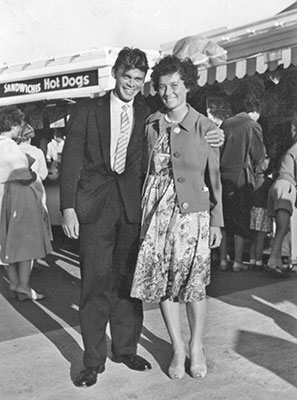
On leaving the Royal Navy in 1960, Frank spent a year as a Milk Recorder for the Milk Marketing Board. He joined the Devon Fire Service on September 25, 1961, working first in Paignton and then Torquay.
Frank passed away in 2012, but in 2010, aged 74, Frank wrote:
I would not change a thing (well not much). Of course, there are things I would have liked to have done, things perhaps I should not have done, things I am proud of, and a few I am not. I don’t think everyone can say that. I have been blessed with a lovely family, some amazing friends, and a life of variety.
